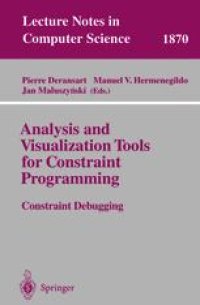
Ebook: Analysis and Visualization Tools for Constraint Programming: Constraint Debugging
- Genre: Computers // Programming
- Tags: Programming Techniques, Software Engineering, Programming Languages Compilers Interpreters, Artificial Intelligence (incl. Robotics), Mathematical Logic and Formal Languages
- Series: Lecture Notes in Computer Science 1870
- Year: 2000
- Publisher: Springer-Verlag Berlin Heidelberg
- Edition: 1
- Language: English
- pdf
Coordinating production across a supply chain, designing a new VLSI chip, allocating classrooms or scheduling maintenance crews at an airport are just a few examples of complex (combinatorial) problems that can be modeled as a set of decision variables whose values are subject to a set of constraints. The decision variables may be the time when production of a particular lot will start or the plane that a maintenance crew will be working on at a given time. Constraints may range from the number of students you can ?t in a given classroom to the time it takes to transfer a lot from one plant to another.Despiteadvancesincomputingpower,manyformsoftheseandother combinatorial problems have continued to defy conventional programming approaches. Constraint Logic Programming (CLP) ?rst emerged in the mid-eighties as a programming technique with the potential of signi?cantly reducing the time it takes to develop practical solutions to many of these problems, by combining the expressiveness of languages such as Prolog with the compu- tional power of constrained search. While the roots of CLP can be traced to Monash University in Australia, it is without any doubt in Europe that this new software technology has gained the most prominence, bene?ting, among other things, from sustained funding from both industry and public R&D programs over the past dozen years. These investments have already paid o?, resulting in a number of popular commercial solutions as well as the creation of several successful European startups.
Content:
Front Matter....Pages -
Debugging of Constraint Programs: The DiSCiPl Methodology and Tools....Pages 1-20
Front Matter....Pages 21-21
An Assertion Language for Constraint Logic Programs....Pages 23-61
A Generic Preprocessor for Program Validation and Debugging....Pages 63-107
Assertions with Constraints for CLP Debugging....Pages 109-120
Locating Type Errors in Untyped CLP Programs....Pages 121-150
Declarative Diagnosis in the CLP Scheme....Pages 151-174
Front Matter....Pages 175-175
Visual Tools to Debug Prolog IV Programs....Pages 177-190
Search-Tree Visualisation....Pages 191-208
Towards a Language for CLP Choice-Tree Visualisation....Pages 209-236
Tools for Search-Tree Visualisation: The APT Tool....Pages 237-252
Tools for Constraint Visualisation: The VIFID/TRIFID Tool....Pages 253-272
Debugging Constraint Programs by Store Inspection....Pages 273-297
Complex Constraint Abstraction: Global Constraint Visualisation....Pages 299-317
Front Matter....Pages 319-319
Using Constraint Visualisation Tools....Pages 321-356
Back Matter....Pages -
Content:
Front Matter....Pages -
Debugging of Constraint Programs: The DiSCiPl Methodology and Tools....Pages 1-20
Front Matter....Pages 21-21
An Assertion Language for Constraint Logic Programs....Pages 23-61
A Generic Preprocessor for Program Validation and Debugging....Pages 63-107
Assertions with Constraints for CLP Debugging....Pages 109-120
Locating Type Errors in Untyped CLP Programs....Pages 121-150
Declarative Diagnosis in the CLP Scheme....Pages 151-174
Front Matter....Pages 175-175
Visual Tools to Debug Prolog IV Programs....Pages 177-190
Search-Tree Visualisation....Pages 191-208
Towards a Language for CLP Choice-Tree Visualisation....Pages 209-236
Tools for Search-Tree Visualisation: The APT Tool....Pages 237-252
Tools for Constraint Visualisation: The VIFID/TRIFID Tool....Pages 253-272
Debugging Constraint Programs by Store Inspection....Pages 273-297
Complex Constraint Abstraction: Global Constraint Visualisation....Pages 299-317
Front Matter....Pages 319-319
Using Constraint Visualisation Tools....Pages 321-356
Back Matter....Pages -
....